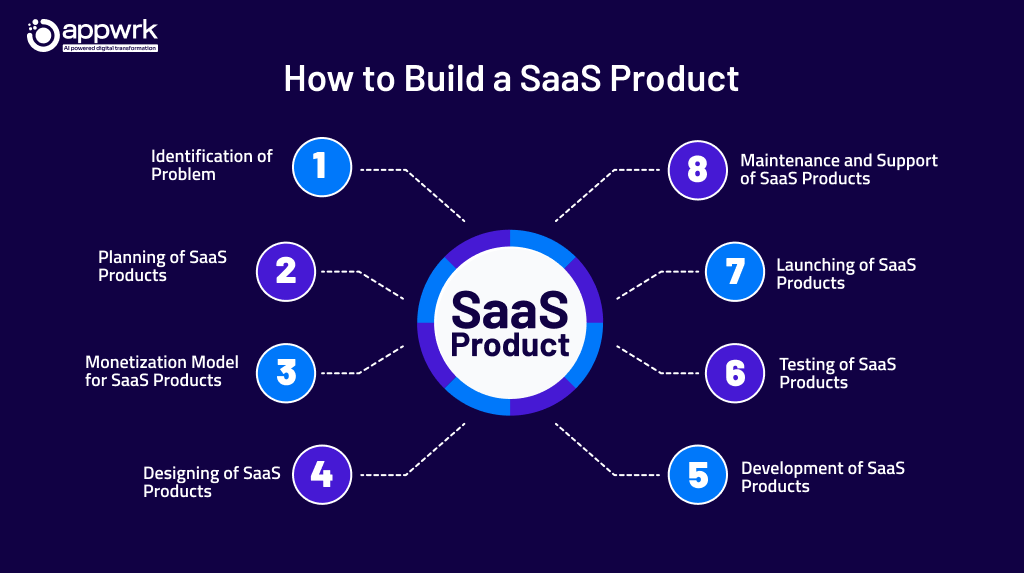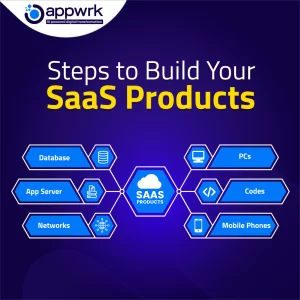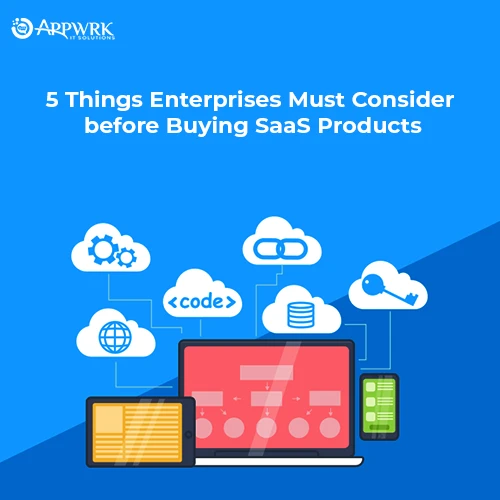8 Easy Steps to Build Your SaaS Products: A Complete Guide
Have you ever used Gmail, Dropbox, Netflix, Clockdiary, and more? These software are examples of SaaS Products! SaaS, Software as a Service, is a way to deliver software applications to customers over the Internet. It makes it easy to use software applications over the internet instead of downloading and running them over on-premises servers.
The SaaS Product market is growing rapidly. By 2024-2031, the market is expected to touch USD 900 Billion with an annual growth rate of 18.7 percent.
Table of contents
What is a SaaS Product?
SaaS (Software as a Service) is a model where software applications are delivered over the Internet instead of downloading them on your computer. SaaS products are applications that are hosted over the internet and made available to users around the globe. Without buying or installing software on your computer, SaaS Products are accessible through a web browser. This makes them easy to use and update since everything is over the internet.
List of Popular SaaS Products
Everything you use on the internet where you log in and use the software interface like e-mail services (Gmail) or storage services (Dropbox) are examples of SaaS Products. Users pay subscription fees for their SaaS products, monthly or yearly. This benefits both users and the cloud provider as it gives leverage to users for accessibility and downloading while creating repetitive income for cloud providers.
Popular examples of SaaS Products that are globally recognized and have huge customer bases include:
- Google Docs
- Clockdiary
- Netflix
- Salesforce
- Shopify
- Slack
- Mailchimp
- Microsoft 365
- Adobe
- Canva
- Trello
- Asana
- AWS (Amazon Web Services)

Benefits of SaaS Products
SaaS product offers significant benefits to both users and developers. These benefits define why SaaS applications are popular in the market. Every SaaS product addresses a problem that is of public interest.
- Cost-Effectiveness of SaaS Software
- Low Initial Cost: Users pay minimal fees and manageable subscription fees, which can be monthly or yearly.
- Low Maintenance Cost: Cloud providers manage SaaS software, so users don’t need to spend on updates.
- Accessibility of SaaS Software
- Global Availability: They are accessible over the internet, which means you can use SaaS applications (clockdiary, Netflix, google Docs) from your computer.
- Compatibility: SaaS software works on multiple devices which makes it compatible with a maximum number of devices.
- Scalability of SaaS Software
- Easy to scale: SaaS applications can be scaled to manage more users or higher usage with minimal or no changes.
- Resource management: Developers can optimize the resources and manage the infrastructure to handle increased user demand and enhance user experience.
- Security of SaaS Software
- Centralized Security: SaaS providers implement robust security measures to protect user data and ensure compliance with regulations.
- Regular Updates: Regular updates reduce the risk of data breaches and protect users from emerging threats.

Steps to Create SaaS Products
To create a SaaS product that has the potential to solve a novel problem and is in market demand. You must follow these steps:
- Identification of a Problem
- Plan Your SaaS Product
- Monetization Model
- Designing
- Development of SaaS Software
- Testing of SaaS Product
- Launch Your SaaS Application
- Maintenance and Support for Your SaaS Product

Let’s discuss these steps in detail:
1. Identification of Problem – SaaS Product
Before building any successful SaaS product idea generation and validation are most crucial because this defines whether your SaaS product is feasible or not. Phases involved in problem identification include:
- Brainstorm Ideas: Write down all the ideas related to your SaaS products that address some problems.
- Market Research: Check whether similar SaaS products are present in the market or not, this will help you to reduce your time and money.
- Define Target Audience: Knowing who will use your SaaS Products is very critical. The target audience helps you design the user interface according to the customer base.
2. Planning – SaaS Products
Once you have a clear idea of your SaaS Product, you can plan to develop your SaaS Products.
Features and Functions: Note the lists of features and functions that your SaaS Products can perform. This helps you solve multiple problems and serve your customers effectively.
Technical Requirements: Define the technologies you will use for your SaaS Products i.e., a specific programming language or framework.
You can decide your features by:
- User needs
- Target Audience
- Business Goals
3. Monetization Model – SaaS Products
Once you have decided upon the idea and features for your SaaS Product, now you have to move on to the monetization model that will help you generate income. Choosing the right income model for your SaaS Products will affect their popularity. There should be a right balance between the service offerings and the compensation for your SaaS product.
Multiple monetization models that help SaaS providers to earn:
- Per-user model: SaaS Products charge for individual access.
- Pay as you go: The price of the SaaS Products is decided based on their frequency of usage.
- Subscription-Based: SaaS Products are charged for only one feature for a certain period.
- Freemium Model: Customers will get some features for free. This model is used for attracting and testing SaaS Products.
- Tiered Pricing Model: Multiple pricing tiers are offered for the SaaS product and the user picks the best fit for themself.
- Feature-Based Model: Customers opt for plans based on the features they need.
- Ads Supported Model: SaaS providers earn based on the advertisement instead of paid features.
4. Designing – SaaS Products
Good design is a must for your SaaS products, which means your SaaS product should be user-friendly and visually appealing. Graphic designer plays a critical in this:
- UI (User Interface): Design your SaaS products’ appearance (how it looks). This is performed with the help of Sketch or Figma. These software are used to create mockups for your SaaS Product.
- UX(User Experience): User interaction plays a vital role in customer retention. Easy navigation will help your SaaS product get customer retention.
5. Development – SaaS Products
This stage requires a developer to build your SaaS product that will help users to solve their problems. If you are not a developer, you might be required to hire a SaaS developer or SaaS development company.
- Backend development: They involve the setting up of servers, databases, and the logic for your specific SaaS product. This requires expert SaaS developers, if you don’t have this expertise you need to hire a SaaS development company or SaaS service provider.
- Frontend Development: This involves all the things that the user sees and interacts with. It involves all the visual elements and user interface, if don’t have an expert graphic designer you need to hire a skilled SaaS developer or SaaS company.
- Integration: SaaS Products often require integration of front-end and back-end at the same time for better functionalities.
6. Testing – SaaS Products
Before launching your actual SaaS Products you have to test all the features offered. There are two steps involved in the testing process:
- Automated Testing: Software tools are used to test your SaaS Products automatically.
- Manual Testing: Real people are used for testing the SaaS Products manually.
7. Launching – SaaS Products
Launching your SaaS product is a very important step! But this requires a marketing plan and attract users.
- Beta Launch: Launching on a smaller platform like making the SaaS product live within small groups or communities.
- Official Launch: SaaS product is made live to the public.
- Marketing: Use social media, blogs, and other platforms to promote your SaaS product.
8. Maintenance and Support – SaaS Products
After launching, maintenance, and support are required to improve your SaaS products’ performance and user feedback. This includes two important steps:
- User Analytics: Track user interaction with your SaaS product.
- Customer Support: Provide excellent support to help users with any issues.
Why Choose APPWRK for Your SaaS Product Development?
SaaS Products provide significant benefits for both cloud providers and users. Creating a SaaS product involves the discovery of a problem, planning, designing, monetizing, launching, maintaining, and supporting your product. SaaS development offers many benefits.
Want to have your SaaS Product Shortly? APPWRK will be your partner. APPWRK’s expert SaaS development services will help you create a robust SaaS product that will scale your business. Contact Us Today! For early development and deployment of your idea be the first to capture the market.

FAQs
Ans: SaaS Products offer several advantages, which make them popular:
Accessibility
Cost-Effective
Automatic Updates
Scalability
Ans: The cost of building SaaS products varies based on complexity, the size of the development team, and the features you want. Here are some general pricing:
Development Team: The cost ranges from $ 50,000-$500,000.
Design: Cost lies between $5000- $50,000.
Marketing: Cost ranges from $ 10,000 to 100,000.
Infrastructure: Cost ranges from $10,000 to $200,000.
Maintenance and Support: Cost lies between $ 20,000- $100,000.
Ans: Selling SaaS products involves attracting customers and convincing them to subscribe to your service. Steps involved in selling the SaaS Products:
Identify the Target Audience
Create Compelling Website
Offer a Free trial
Use digital marketing
Ans: Launching a SaaS product involves several key steps:
Beta Testing
Marketing Campaign
Set up Customer Support
Monitor and Adjust
Ans: The time taken to build a SaaS product depends on various factors (product complexity and the development team size). Usually, it takes around 8-12 months to create SaaS products from scratch.
About The Author




 Free Quote
Free Quote
















































